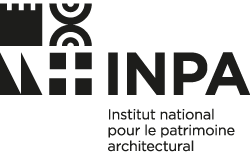Style and typology of the parterres
The two parterres of the park were recreated “in the spirit of the 18th century” by the architect Henri Luja. The parterres join at the central fountain basin, called “rond d’eau”. They are conceived as so-called “parterres à l’angloise”, which means large carpets of lawn surrounded by flower borders and low box hedges. The term “à l’angloise” goes back to a specific type of parterre much in favor in England in the 18th century.
Technical vocabulary and ornamental features in parterres
The “plate-bande”, or flower border
The strips of flower borders are punctuated at regular intervals by fastigiated yew trees, trimmed as topiary figures, along the paths and borders.
The embroidery (“broderie”) and the various earth colors (“sables”)
The various earth colors are specific to the mineral part of the parterre’s design. Somehow, it’s the backdrop to set off the embroidery. In Echternach the crushed red brick is the only color backdrop for the embroidery.
The “palmette” and the “rinceaux”
The central box embroidery motif in the main parterre facing the pavilion consists of a shell (“coquille”), or “palmette”, i.e. five lobes bounded by a circular segment. This fan-like decorative motif is most likely inspired by a scallop (coquille Saint-Jacques).
The terms “coquille” and “palmette” alternatively occur in order to describe this type of ornament in French parterres. “Palmette” may derive from the latin word “palma”, i.e. hand, or be inspired by the foliage of the palm tree.
The palmette is often accompanied by foliated ornaments of volutes and scrolls. These are called “rinceaux” (branches of foliage) in the art of the parterre.
Two sprigs of foliage (“feuille de refend”), adorned with so-called raven’s beaks (“becs de corbin”) frame the “palmette” of the Echternach parterre. A delicate flower stalk unfolds from the “rinceaux”, producing a simple flower with two petals. The “rinceaux” emerge from the flower borders that are contorted in volutes at the head of the main parterre. In this way the two “rinceaux” accompany the palmette which starts from the central stone urn.
The urn
The stone urn of the parterre is a reused feature of the pre-war flowerbed of the 1920s. Its lid is decorated with an ornamental artichoke. The restituted body of the urn, which was missing for a while, has been carved in sandstone.
The different stages of restoration interventions in the parterres
Following the initial architectural and historic study of the park (2022) a specific stylistic analysis of the two parterres (2023) has been conducted in order to prepare its restoration.
The following structural interventions are to be made:
- relocation of the urn at the centre of the broderie.
- installation of metal border edging, confining the contours of the parterres from the gravel paths
- soil amendment of the flower borders and renewal of the crushed brick dust
- replanting of the box borders and the box embroidery
- planting of flower beds in two stages:
- temporary flowering in advance of the planting of the box borders
- final planting of flower beds according to seasonal flower schemes

A.-J. Dezallier d’Argenville, 1709, “Parterre à l’Angloise” (detail)

Liger Louis, La Nouvelle Maison Rustique, 1777 (11th ed.), Volume 2, No. 20, parterre

Detail of a flower bed, Veitshöchheim Park

Verification based on the precise design of the original embroidery

Lower part of the urn body (copy)

Urn lid (original)

Iron lattice in progress

Parterre before restoration, c. 1950/55

